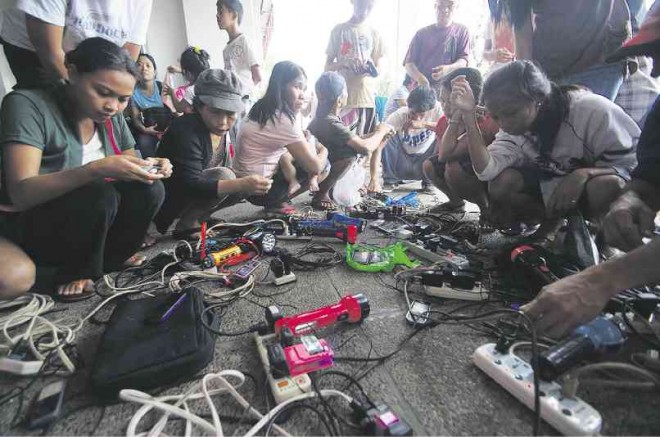
Hundreds of residents in the capital city of Borongan in Eastern Samar charge their cell phones and flashlights at the provincial capitol. Supertyphoon “Yolanda” toppled telecommunication towers and power transmission lines in the province when it struck on Nov. 8. RICHARD BALONGLONG/INQUIRER NORTHERN LUZON
TACLOBAN CITY, Leyte, Philippines — The government will be building more than 100 bunkhouses to serve as temporary housing for the families in Eastern Visayas who lost their homes due to Supertyphoon Yolanda (Haiyan).
The bunkhouses will be built in Tacloban (10 units) and Palo (10) in Leyte; Basey (11) and Marabut in Samar (18); and Guiuan (26), Hernani (30) and Giporlos (3) in Eastern Samar, Rolando de Asis, regional director of the Department of Public Works and Highways (DPWH) in Eastern Visayas, said at a briefing of the Task Force Yolanda.
The briefing was held at the Leyte Sports Development complex and was presided by Social Welfare and Development Secretary Corazon Soliman.
De Asis said that each bunkhouse, made of GI sheets, plywood and cement for the floor, was estimated to cost P959,360. Each bunkhouse will have 24 rooms with a dimension of 7×28 meters and a window for ventilation. The bunkhouse will also have a common cooking and bathing area.
Each room could accommodate between five and eight persons, Soliman said.
Soliman explained that the roads and drainage canals would be built during the site development to ensure sanitation among the families who would occupy the bunkhouses.
The funding for the site development would come from the local government units concerned, she added.
Soliman said that the proposed bunkhouses were similar to the facilities constructed in Cagayan de Oro City for the survivors of storm Sendong.
The respective local government units, in coordination with their social welfare and development offices, would identify the families who would occupy these bunkhouses, she said.
But the families with pregnant mothers, senior citizens and physically disabled members would be given priority, Soliman said.
Soliman said the bunkhouses would serve as temporary shelter for these families until the completion of their new housing units at permanent relocation sites.
Tacloban City administrator Tecson John Lim said that the proposed bunkhouses for the city would be built in the Abucay area and along the national diversion road in Barangay Caibaan.
Lim, however, could not say when the construction of bunkhouses would start as the city government must develop the proposed sites first.
Based on the records of the Department of Social Welfare and Development (DSWD-8), about 273,782 families across the region were displaced due to Yolanda. Of this number, 55,927 families are from Tacloban.
However, the DSWD does not have any figures yet on the number of destroyed houses in the region.
At the Tacloban City Astrocome, the biggest evacuation center in the city, the Department of Health fumigated the surroundings to prevent the occurrence of dengue fever.
Dr. Paula Paz Sydiongco, DOH assistant regional director in Eastern Visayas, said they decided to take preventive measures even if no report of a dengue fever case has been reported to their office.
Pools of stagnant water left by floods caused by typhoon Yolanda could serve as breeding ground for dengue fever-causing mosquitoes.
The fumigation has been done in coordination with a medical team from Japan, she said.
Aside from the Astrodome, the regional DOH would also fumigate other areas with stagnant water, Sydiongco said.
Related stories
Saving Grace: Canadian rushes to Ormoc to rescue fiancee
Pacquiao prepares for Tacloban visit after win
Chinese hospital ship arrives in Leyte
Samar folk say they will rebuild town from scratch
President concedes ‘Yolanda’ death toll has doubled